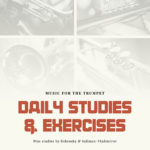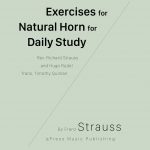Arban’s Daily Exercises (Gymnastics for the Cornettist)
With the release of this book and its two counterparts, you are witnessing the single biggest release of never before seen, long lost Arban trumpet books, translated into English for the first time since they were written in the mid 1880's. Arban's Daily Exercises is subtitled "Gymnastics for the Cornettist." In his foreword, he tells the reader that "the exercises contained in this collection are sufficient to maintain the agility of one’s fingers, the strength of the embouchure, the suppleness of the lips, as well as the evenness and lightness of the tongue. These exercises have been combined such that the artist will immediately find the perfect studies for all genres." He walks you through how you should practice each section, then he provides all of the exercises you need to maintain your chops, starting with flow studies, intervals, lip slurs, major, chromatic, and diminished scales, triplet arpeggios, double tongued major chords, and then articulated studies to be played on only one fingering as if you were playing a natural trumpet. A find like this is literally one in a century. My special thanks to Kelsey Anderson for working so diligently on a challenging translation. Please check out the first page in the samples, then click above to get an immediate PDF download, a print copy, or both.
Daily Studies & Exercises for Trumpet
These exercises are for the daily practice of trumpet players. They may be used by beginners, students of musical colleges and conservatories, and also by professional trumpet players. This textbook develops various aspects of the performer's physical apparatus (breathing, lips, and fingering techniques) and different articulations (attack, legato, staccato, double and triple tonguing, marcato, etc.). The exercises should not be mechanically played, instead it is necessary to control the playing to achieve as beautiful a sound as possible. This compilation consists of four independent sections, which may be played alternately, depending on what type of shape the player is in. Don't worry if they look difficult, If the performer has limited capabilities, they should exclude the material in brackets. This compilation includes exercises by prof. M. Tabakov, prof. S. Eryomin, prof. G. Orvid and others for added variety and interest. You will find a set of Six Studies by Bobrovsky, and Four Studies by Saliman-Vladimirov, too. Many thanks to Michael M. Filatov for his help with the translation into English. To the left you can find some samples, then above you can grab an immediate digital download.
32 Daily Lip & Tongue Exercises for Trombone
Ernst Gaetke writes of these studies: "These lip and tongue exercises have been written for the very purpose of passing with ease from the bass to the treble areas of the trombone range and visa versa. These exercises afford the only means of overcoming this difficulty, as the manipulation of the sliding-tube impedes execution in quick time, treating these movement as a purely mechanical action solely dependent upon a skillfully trained right arm. These exercises have been divided into sections systematically arranged according to the degrees of technical difficulty. They are written for each position, to force the pupil to study it in every position which, as experience has taught, he would not do, of his own accord." This is a wonderful collection of lip flexibilities and tonguing exercises. Suitable to players at all levels and a staple to the repertoire of all serious players. Click to the left for samples then grab an immediate PDF download above.
Modern Daily Warm-Ups & Drills
(Ilmari) Elmer Ronka's study books for trombone, baritone, and tuba are a staple of any serious player's collection. In the preface of this book, Ronka lays out why he wrote it and what his goals were: "A good warm up routine is vital to all players, so I wrote a choice of two warm ups, preceding the essential drills section of this book. The combined material was created on the basis of long experience as a private teacher of hundreds of brass players, many who are professional performers in symphony orchestras, bands and in jazz fields throughout the country. Although these studies are aimed for the professional and advanced student, the use of the first few exercises in each group will be of advantage in starting and playing correctly for the beginner under the guidance of a good teacher." Check out some samples to the left then grab yourself an immediate PDF download above.
French Horn Prime Day 2021
Dearest qPress fans, much to our dismay, Amazon cancelled October Prime Day at the last second. BUT, since we already had some huge promotions planned, why should you guys miss out?
Ralph Allan Schwartz Endorsements
Read endorsements by Manny Laureano, Ryan Gardner, David Baldwin, William Vacchiano, David Gilbert and more for Ralph Allan Schwartz' new book "Trumpet and the Language of Music."
Daily Drills and Technical Exercises
Have you ever wondered how players like Wynton Marsalis have developed such strength, endurance, and control on the trumpet? This book holds the key. Every day Wynton would start with this book: "During the first 15-20 minutes play long tones, soft, from second line G down to low G. For the next 30-45 minutes work with pages 5 and 6 in the Max Schlossberg book, varying the dynamics and the tempos. Try to play through every slur, getting an even, round sound on every note, and getting over the breaks in the instrument. Also, exercises 59 and 60 in the Schlossberg book are good to strengthen your lips." -Wynton Marsalis Written by renowned teacher Max Schlossberg, this book demonstrates his well-regarded methods on mastering the trumpet. It is especially useful for developing the upper register, from G2 to C5. Used by schools, universities, and conservatories the world over. Click to the left for samples and above to get your copy today! Select from digital and print versions.
Daily Exercises & Scales
Advanced Daily Studies for Trumpet
For those with the desire to better themselves in transposition, strengthen lip muscles, increase range, and endurance; develop firm and sure fingering, rapid tonguing and the mastery of intricate intervals, this book will prove indispensable. An original idea in a revolving scale that gradually expands into a two octave range is ideal for increased range building and added proficiency in scale perfection. The chapters are so arranged that all studies, with the exception of the studies in keys of C and f, (i.e. 4th and 7th chapters) can be interchanged with different keys by a change of key signature. The varied models and articulations that appear at the beginning of each study are important for the development of ear training and speed of the single tongue. This book is a part of the Charles Colin Complete Method, a set of 7 books written to cover all areas of study for the modern trumpeter. A selection of samples are available on the left. Check then out then grab an immediate PDF download above.
Exercises for Natural Horn for Daily Study
Although best known as the father of Richard Strauss, Franz Strauss was an incredible musician in his own right. A composer, multi-instrumentalist, and virtuoso horn player, Franz Strauss was was principal horn player of the Bavarian Court Opera for over 4 decades and a teacher at the Royal School of Music in Munich. Contained in this volume is both instruction and exercises for playing the natural horn. The exercises start out simple, but over the course of the book increase in difficulty to virtuoso level. This edition was revised by the composer's son, Richard Strauss, as well as Hugo Rüdel and has been translated into English for the very first time right here at qPress. Check out a few samples from the beginning of the book to the left and then click above for a full PDF download of the entire book.









